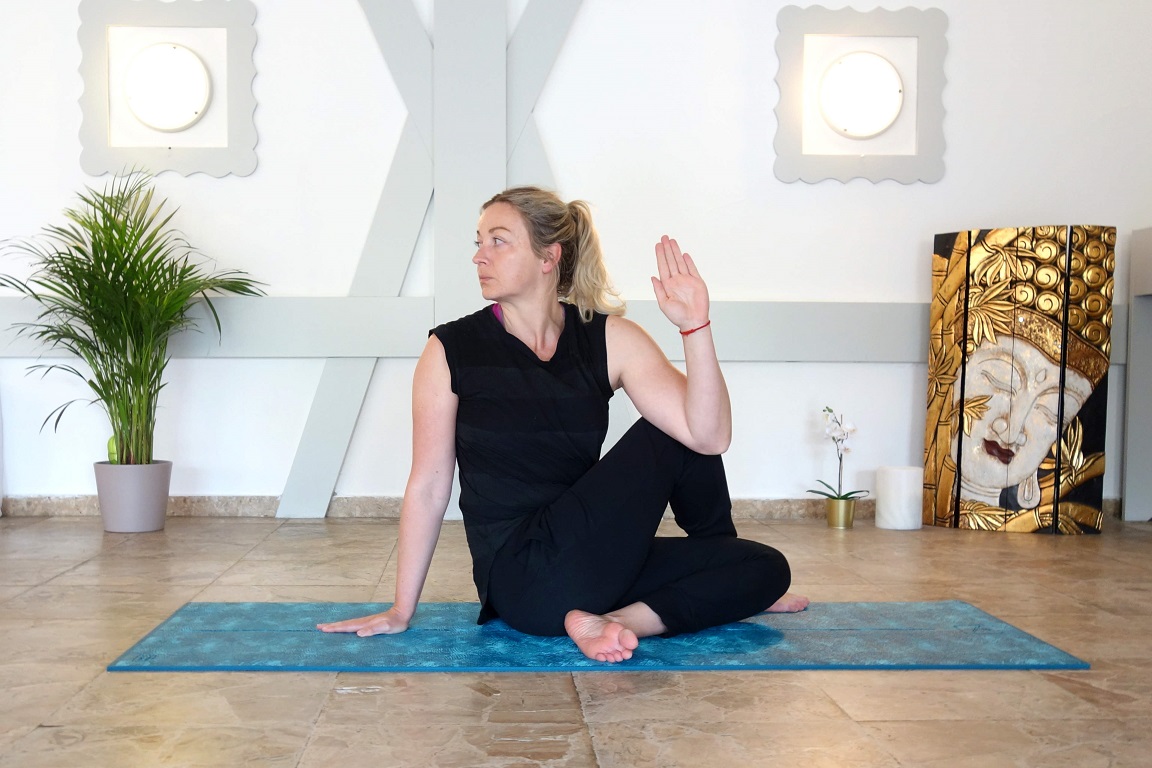Yoga for burnout. The burnout syndrome is caused by stress – both professional and private. It builds up over months or even years and is usually only taken seriously when it comes to total collapse. Do not wait that long and do something good for you now!
When stress becomes too much
We cannot remove stress from our lives. We cannot change other people and situations. But what we can change is how we deal with stress. Yoga is a healthy form of stress management. Yoga is not about performance, it's about introspection - looking inwards. Your own self and wellbeing are in the focus. Yoga is holistic, it includes body, mind, emotions and the soul.
Yoga for burnout – Asanas

Parvatasana (mountain pose) strengthens legs and back. It stimulates blood flow to the brain and shoulders, relieving tension. It minimizes stress and fatigue.

Balasana (child pose) calms body and mind. It stretches the spine releasing tension. This relaxation pose helps with stress and anxiety.

Ardha Matsyendrasana (Half spinal twist) stretches the abdomen and back, strengthens the nerves of the spine and regulates the secretion of the adrenal gland (adrenaline, cortisol).

Tadasana (palm tree pose) gives stability - physically and mentally. It strengthens the nerves, improves the steadiness and has a calming effect. You can totally concentrate on yourself.
Yoga for burnout – Pranayama
Watch your breathing for a few moments. Most of the time we breathe flat and rather fast. Ideal, however, would be deep, calm and conscious breathing. The breath brings prana (life energy) into our body. The added oxygen allows us to be alert and attentive. In addition, deep breathing brings us to our own center. We relax and are present at the moment. Abdominal breathing is therefore very important, especially to calm the mind and body.
Abdominal breathing should extend to the diaphragm so that prana reaches the internal organs. Place the right hand just above the navel on the stomach and the left hand on the chest. The right-hand moves up while inhaling and down when exhaling. The left hand should not move at all. There should be no tension in the abdomen. Do not try to force the movement in any way. Try not to dilate your chest or move your shoulders. Feel the belly expand and contract.
Yoga for burnout – Meditation
 To prevent burnout or get out of burnout, the first step is to recognize your own condition. With mindfulness meditation, you can feel mild changes such as mood swings, fatigue or lack of concentration. This type of meditation helps us to get to know our body better and to respond more quickly to imbalances.
To prevent burnout or get out of burnout, the first step is to recognize your own condition. With mindfulness meditation, you can feel mild changes such as mood swings, fatigue or lack of concentration. This type of meditation helps us to get to know our body better and to respond more quickly to imbalances.
One of the simplest forms of mindfulness meditation is to focus on your own breath. Sit in a quiet place where you won’t be disturbed. Close your eyes and start watching your natural breathing rhythm. Feel the air at the nostrils and how it flows deep into your body. If your thoughts drift away, bring your attention back to your breath. This exercise should be practiced daily for 15 minutes. For example, it can be integrated into your evening routine before going to sleep.
Ayurveda for burnout
According to the tradition of Ayurveda, burnout is a consequence when the life fire Agni is weakened. As a result, there is a lack of substantial as well as energetic life energy. This leads to a variety of physical symptoms and a disturbance of wellbeing. Furthermore, too much vata (the elements air and ether) is in the body and in the mind.
Ayurveda offers a wide range of methods and techniques to rekindle the fire of life. Particularly beneficial are sleep-inducing full body oil massages and Shirodhara (pouring oil over the forehead). You should treat yourself to this at least twice a week to balance the mind and to stimulate the flow of energy. In addition, Vata should be reduced.
Ayurvedic Tips to reduce Vata
- ♥ Regular daily routine (fixed times for eating, sleeping, exercise)
- ♥ Drink warm water instead of cold water
- ♥ Eat warm, cooked food (no raw food)
- ♥ Use warming spices (ginger, turmeric, cumin, black pepper)
- ♥ Regularly eat ghee, honey, nuts, and milk
- ♥ Daily meditation
- ♥ Go into nature at least three times a week
Appreciation - accept yourself
In addition to stress, one's own esteem and love for oneself play a major role. It's about taking time and learning to listen to your own needs. Too often, the problems of others are in the focus. Now is the time to get your own wishes and dreams out of the drawer again. Do what's good for you. Do what you enjoy.
I wish you the strength to communicate your needs and wishes. As always, I'm happy about questions, suggestions, and comments!

